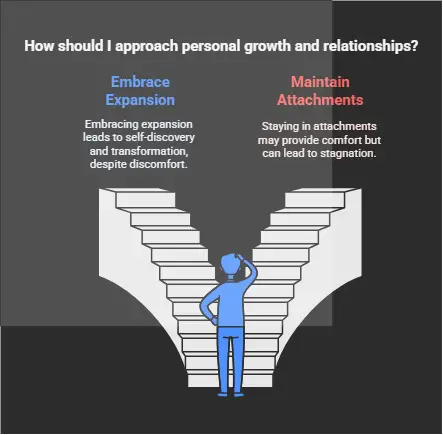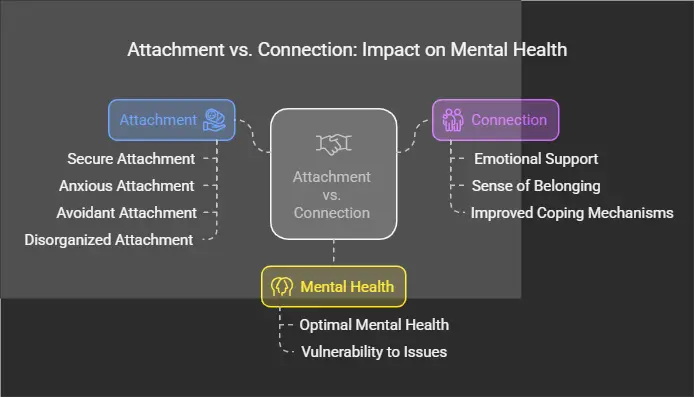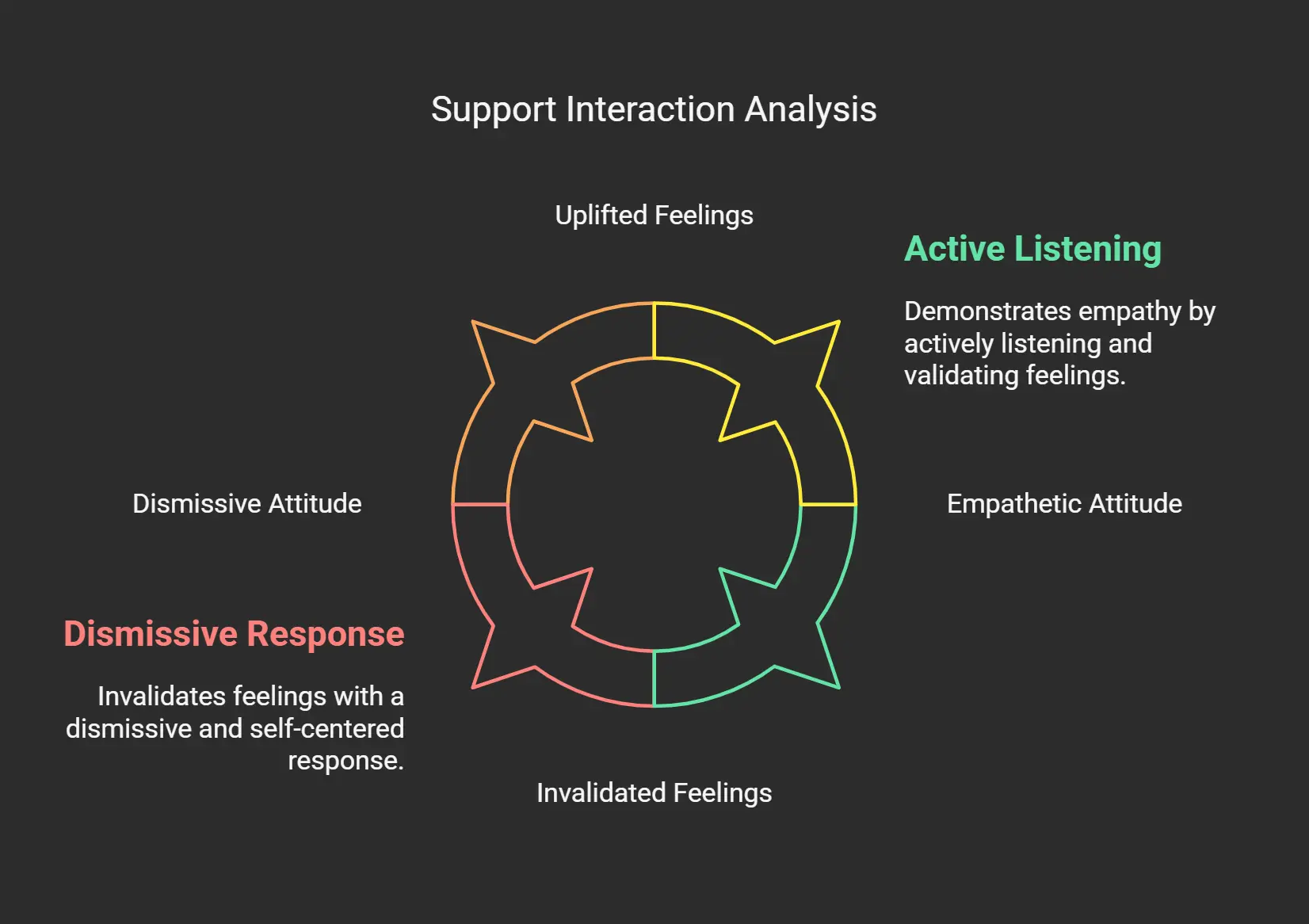What Is Spiritual Expansion and How Does It Differ From Attachment?

Spiritual expansion is the ongoing evolution of consciousness through personal growth, self-awareness, and the embrace of change. Unlike attachment, which stems from fear and keeps you stuck in outdated patterns, expansion encourages meaningful connections that support your evolving identity.
Prioritizing expansion over attachment leads to relationships, careers, and experiences that align with your authentic self
Why Do People Feel Stuck in Life?
Many people remain trapped in unfulfilling relationships, careers, or routines despite feeling drained. This stagnation occurs because we confuse attachment with genuine connection.
Our brain’s natural preference for comfort and familiarity makes us cling to what we know, even when it no longer serves our growth.
The fear of the unknown often weighs more heavily than the discomfort of staying put. This creates a cycle where comfort zones become comfort traps, preventing the expansion necessary for conscious living.

Understanding Spiritual Expansion vs. Attachment
What Is Spiritual Expansion?
Spiritual expansion is the continuous evolution of your mind, emotions, and consciousness toward greater self-awareness and authentic living.
Key characteristics of expansion:
Neuroplasticity research shows that repeated exposure to new experiences rewires the brain, making change progressively easier. The amygdala initially triggers fear responses to uncertainty, but the prefrontal cortex can learn to reframe risk as opportunity through conscious practice.

What Is Attachment in a Spiritual Context?
Attachment is an emotional dependency on people, situations, or identities based on fear, comfort-seeking, or resistance to change rather than genuine alignment.
How attachment manifests:
Spiritual Expansion vs. Attachment: Key Differences
| Aspect | True Connection (Expansion) | Unhealthy Attachment |
|---|---|---|
| Foundation | Mutual growth and respect | Fear, dependency, obligation |
| Energy | Uplifting and energizing | Draining and restrictive |
| Motivation | Alignment with values | Avoiding discomfort |
| Outcome | Personal evolution | Stagnation |
| Flexibility | Adapts as you grow | Resists change |
| Independence | Maintains autonomy | Creates codependency |
How Does Attachment Disguise Itself as Connection?
Attachment feels like a connection because it provides temporary emotional security. The brain interprets familiarity as safety, even when that familiarity is unfulfilling. This creates an illusion of stability that’s actually based on fear of change rather than genuine compatibility.
Common Attachment Patterns
In relationships:
In careers:
In identity:

Emotional Cost of Avoiding Growth
Research shows that resisting personal expansion leads to:
Why Does Spiritual Growth Feel Uncomfortable?
The Neuroscience of Resistance to Change
Your brain is evolutionarily wired to prioritize comfort and certainty. The amygdala—your fear center- interprets change as potential danger, triggering fight-or-flight responses.
Meanwhile, the prefrontal cortex struggles to balance risk assessment with reward potential, making the unknown feel threatening.
However, neuroplasticity demonstrates that repeated exposure to new situations creates new neural pathways. Over time, what once felt uncomfortable becomes your new baseline, making continued expansion progressively easier.
Spiritual Perspective on Growth Discomfort
From a consciousness perspective, discomfort signals transformation, not failure. Ancient wisdom traditions recognize that:
“Attachment often feels safe, but true growth requires embracing the discomfort that signals you’re moving beyond familiar limitations.”
How Do You Know If You’re Attached or Connected?
Signs You’re Holding Attachment Instead of Connection
✅ Self-Assessment Checklist:
Relationship indicators:
Career indicators:
Personal growth indicators:
If fear of loss is your primary motivation for staying, it’s attachment, not connection.

How to Release Attachment and Embrace Expansion
Step 1: Identify What’s Holding You Back
Action items:
Journaling prompt: “What in my life consistently drains rather than enriches my energy?”
Step 2: Acknowledge Fear Without Letting It Control You
Fear of change is natural; your brain prefers known discomfort over an unknown possibility. The key is recognizing fear as information, not instruction.
Fear-processing exercise:
Studies show that 85% of feared outcomes never materialize, while 79% of people who made feared changes reported improved life satisfaction within six months.
Step 3: Shift from Scarcity to Abundance Mindset
Scarcity mindset: “If I leave this relationship/job, I won’t find better.”
Abundance mindset: “Better-aligned opportunities exist beyond my current experience.”
Reframing practices:
Step 4: Take Small, Intentional Steps Toward Expansion
Growth doesn’t require dramatic overnight changes. Small, consistent actions build momentum:
Practical micro-steps:
Implementation timeline:

How to Build Relationships That Support Expansion
Characteristics of Growth-Oriented Connections
What to look for:
Setting Boundaries With Energy-Draining Relationships
Boundary-setting framework:
Communication:
“I value our relationship and need to be honest about my capacity. I’m focusing on [personal growth area] and need to [specific boundary]. I hope you can understand and support this.”
Discover Your Inner Self. Join Our Self-Mastery Program.
Self-Mastery Coaching gives you the space, tools, and guidance to grow, reflect and discover your values and inner strength.

The Dependency Paradox
Research demonstrates that individuals who feel secure in relationships are more likely to pursue personal growth and autonomy. Supportive connections foster independence rather than hindering it, the opposite of attachment patterns.
Example: A friend who supports your career transition versus one who discourages change to keep you available.
Daily Practices for Staying Aligned With Expansion
Meditation for Inner Guidance
Practice: 10-15 minutes daily of silent meditation quiets external noise, allowing access to inner wisdom.
Benefits:
Subscribe to Create Higher Vibrations!
Get Inspiration and Practical advice straight to your inbox.
Journaling for Self-Discovery
Prompts for expansion:
Frequency: Daily 10-minute sessions or weekly 30-minute deep dives.
Stepping Outside Comfort Zones
Progressive challenge approach:
Each successful step builds confidence for more substantial changes.

What Are the Long-Term Benefits of Prioritizing Expansion?
Personal Transformation Outcomes
Individuals who consistently choose expansion over attachment report:
Professional Growth Results
Career impact of expansion mindset:
Stronger professional networks
Higher likelihood of career advancement
Increased earning potential (average 24% over 5 years)
Greater job satisfaction
Enhanced creativity and innovation
Your Next Steps for Conscious Expansion
Immediate actions (this week):
30-day implementation plan:
Long-term commitment:
Conclusion
Letting go doesn’t mean abandoning what matters—it means creating space for what aligns with who you’re becoming. The discomfort of change is temporary, but the regret of staying stuck in patterns that no longer serve you lasts indefinitely.
When you prioritize expansion over attachment, you open the door to relationships, opportunities, and experiences that reflect your evolving, authentic self. You realize you’re not losing anything, only making space for something greater.
The question isn’t whether you should let go, but whether you’re willing to trade stagnation for conscious growth.
The choice is yours. Start small, trust the process, and remember that every step toward expansion is a step toward your most authentic, fulfilling life.


